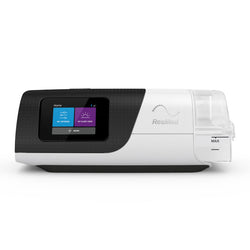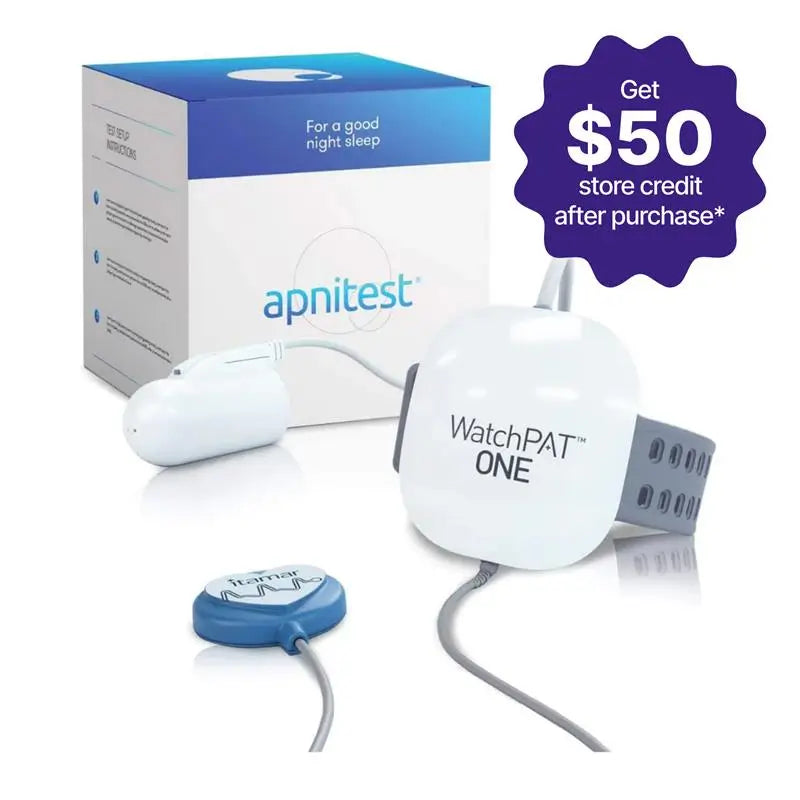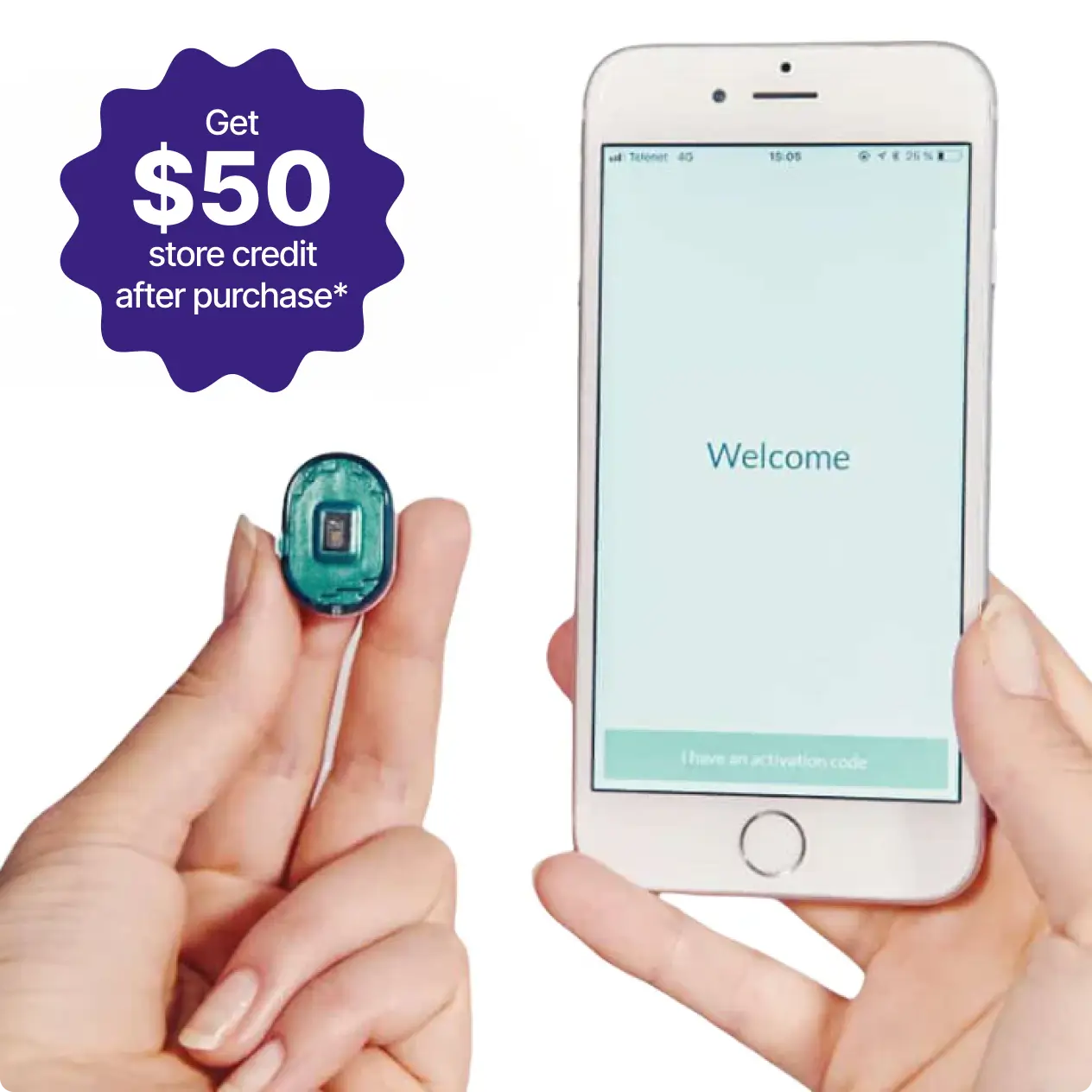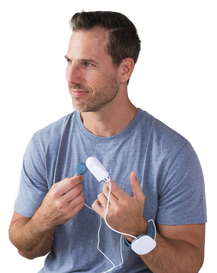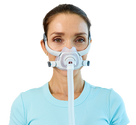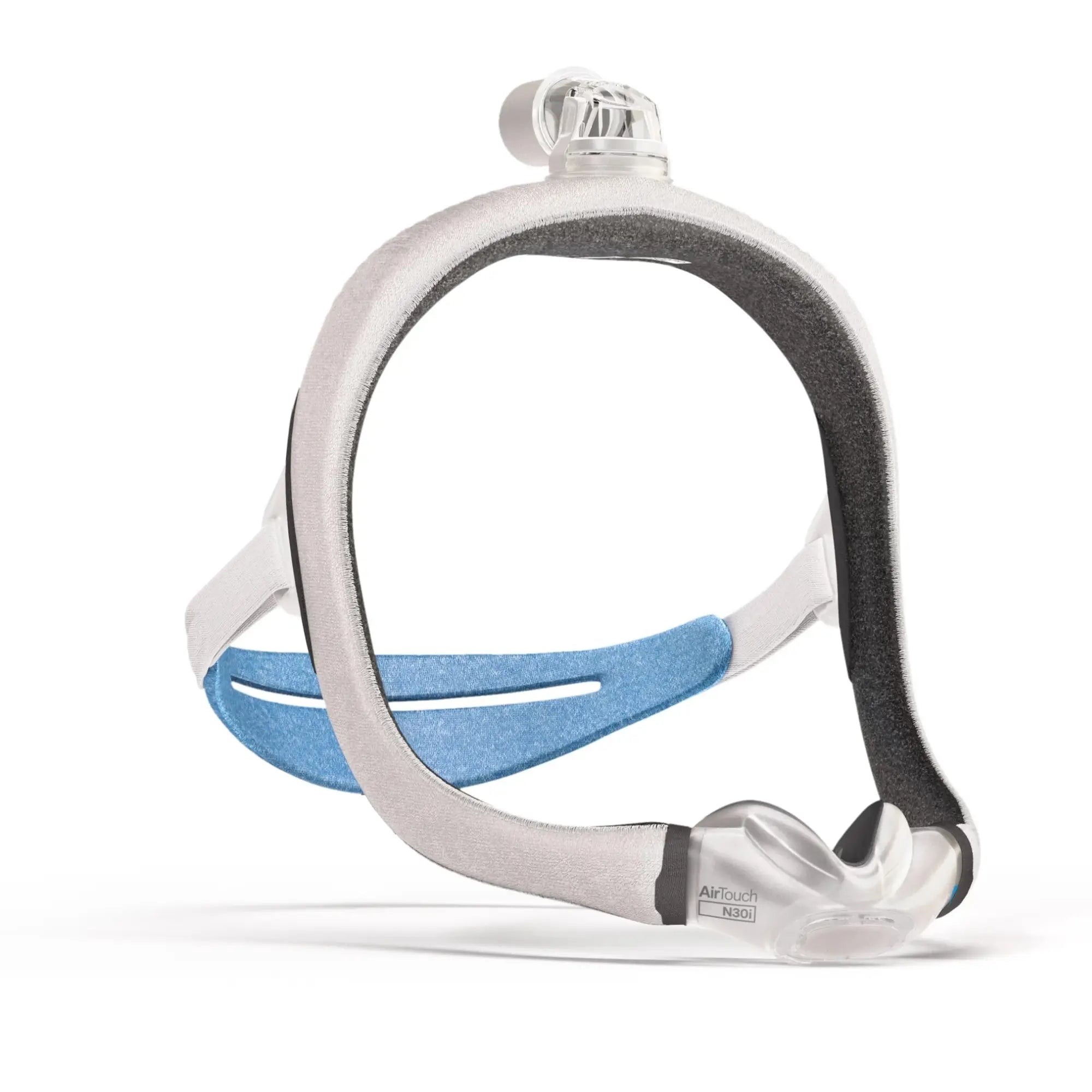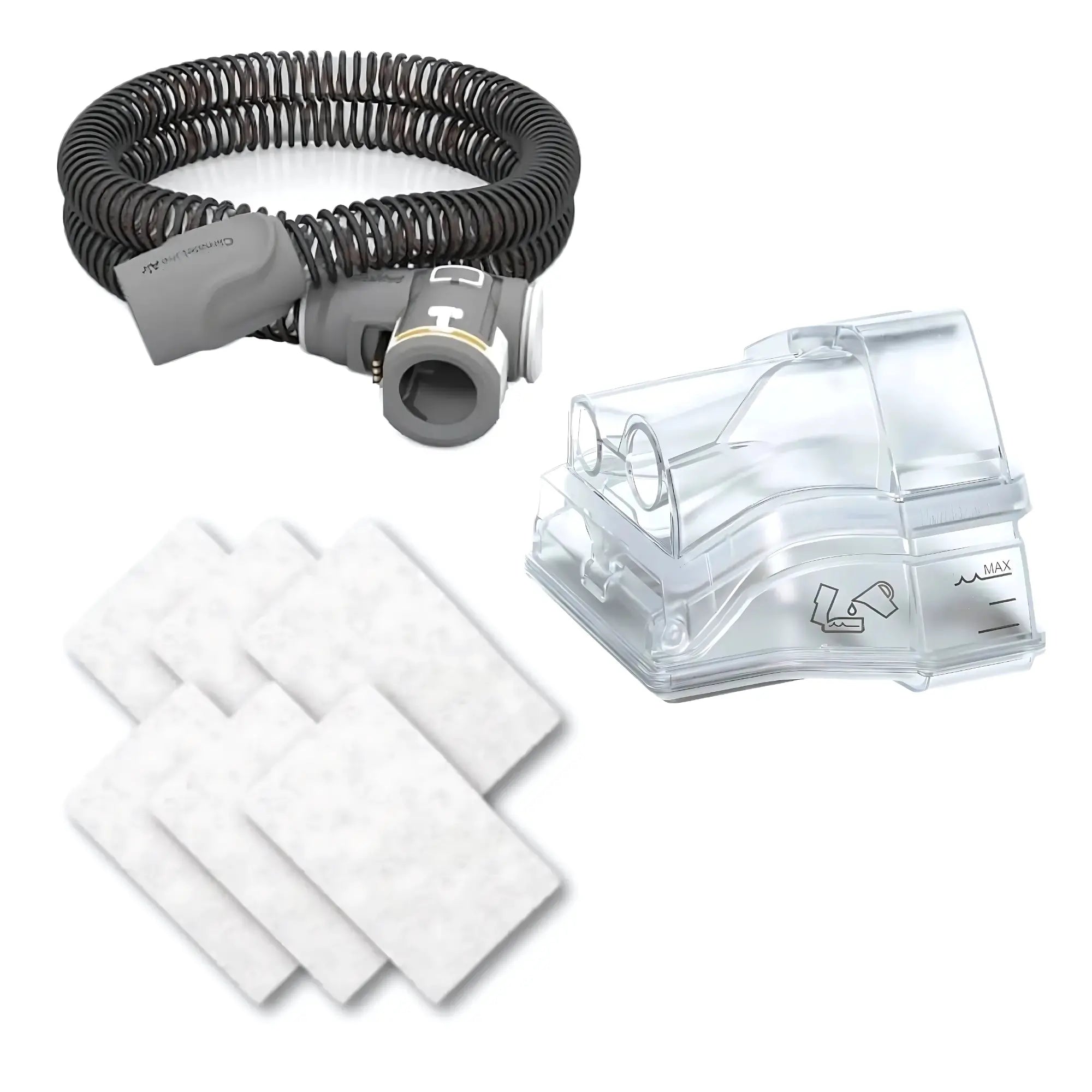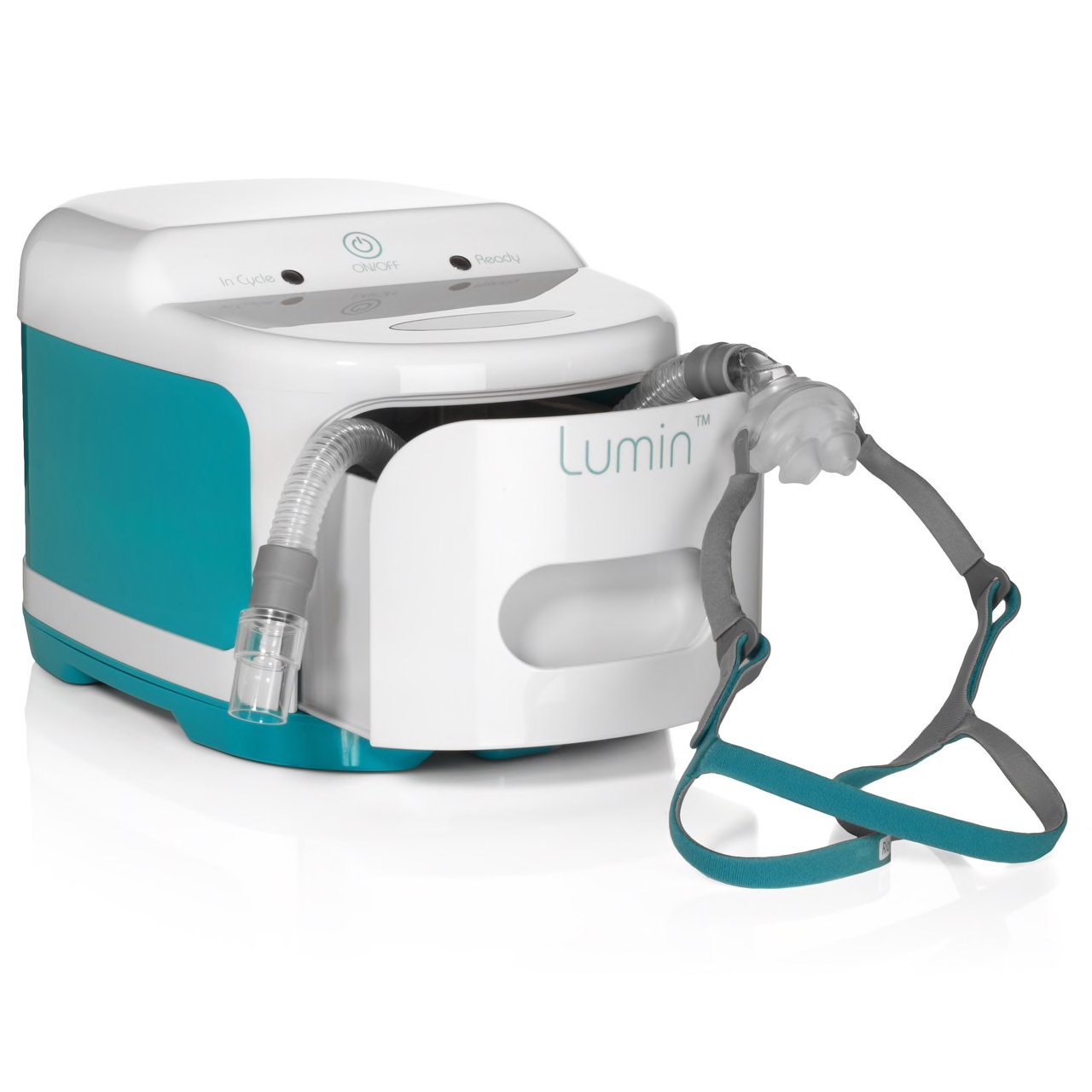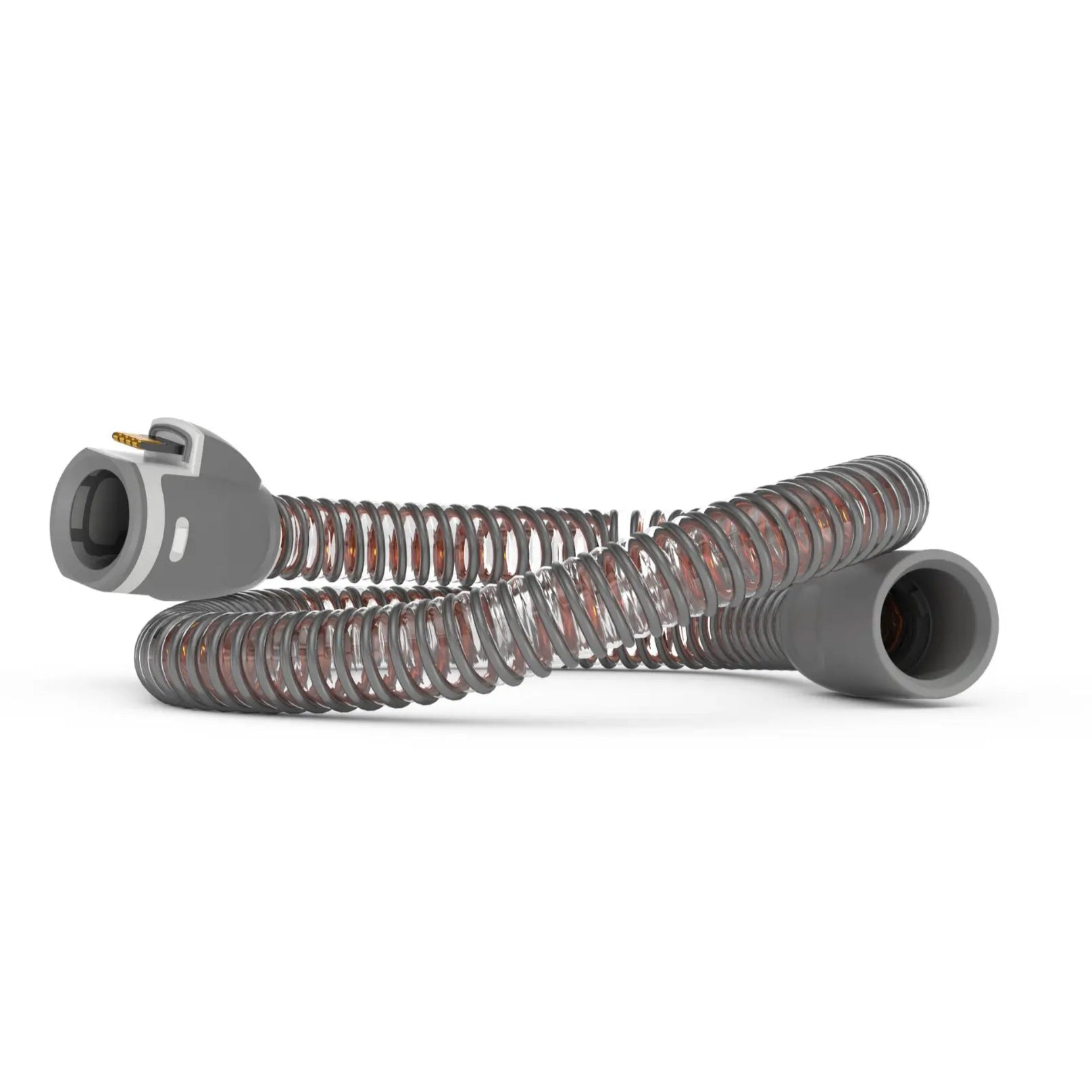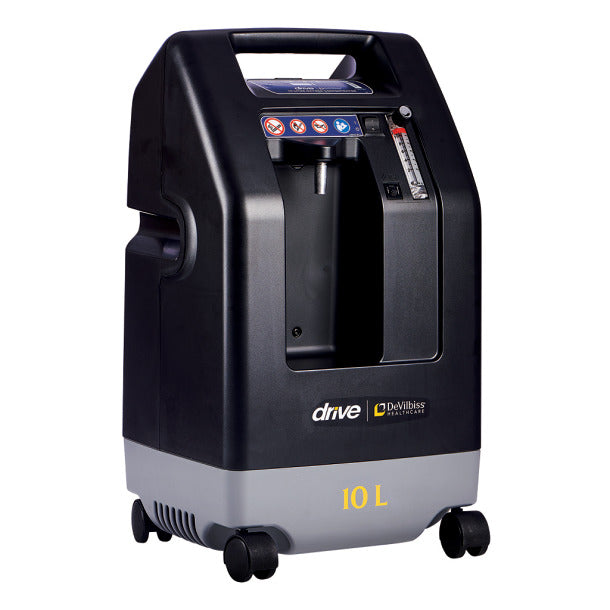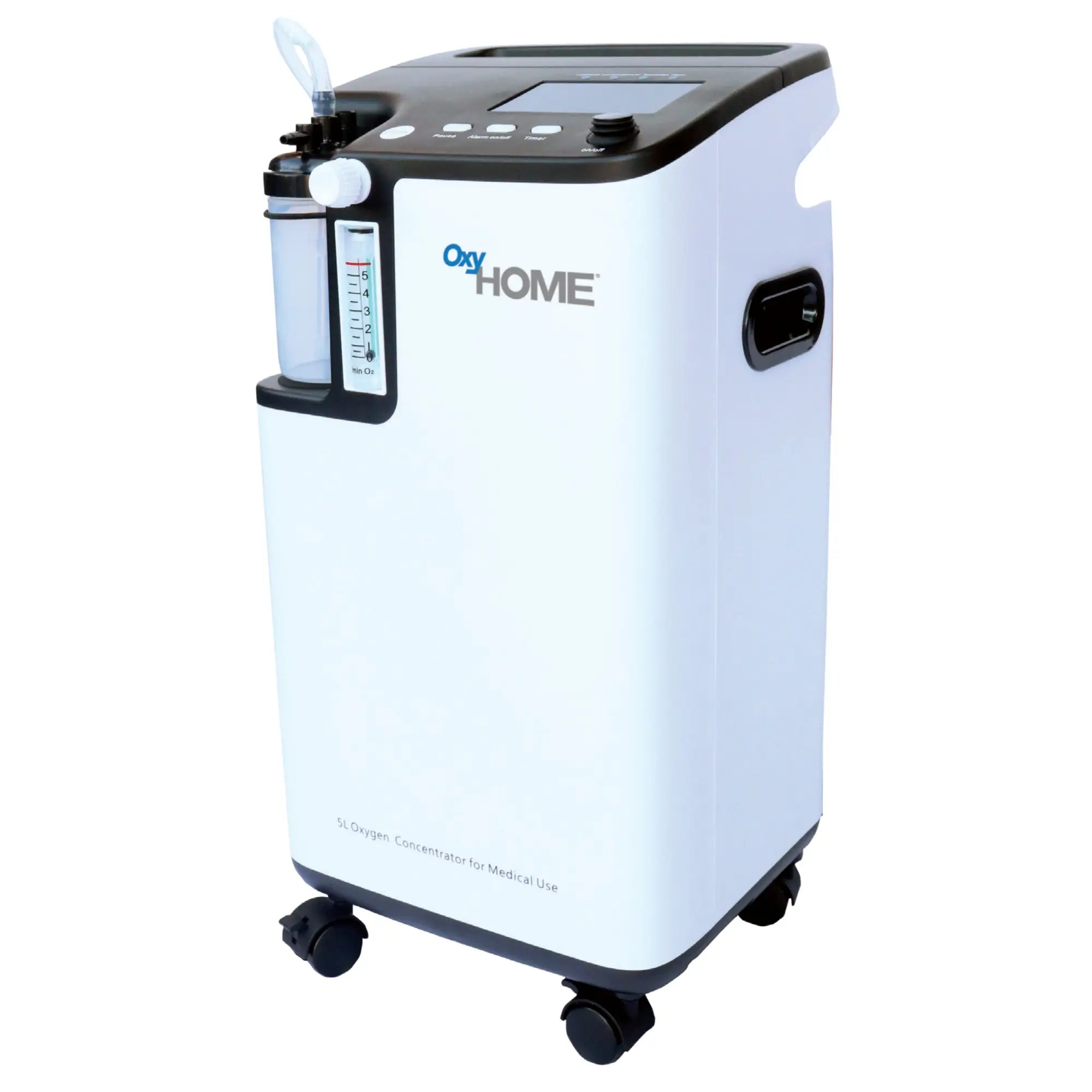Let’s face it: cleaning your CPAP gear might be the last thing on your mind after waking up. Maybe you forget sometimes, or perhaps you're just not sure how often is really necessary. Sound familiar? While skipping a clean might seem harmless, it's a fast track to trouble. Think gunky buildup, potential sickness, and even cutting your equipment's lifespan short.
Ignoring your CPAP cleaning routine invites unwanted guests. Skin oils, bacteria, and even mold can quickly set up shop in your mask, tubing, and water chamber. What's the big deal? This microscopic mess can lead to nasty skin rashes, irritation, or worse – respiratory flare-ups and infections if germs get cycled back into your airways.
But hold on – before you reach for the industrial-strength cleaners, let's talk balance. While keeping things hygienic is crucial, a recent study suggests that going overboard with aggressive cleaning doesn't necessarily lower infection rates compared to regular, sensible washing. [1] In fact, the study points out that constantly stressing about potential germs can actually increase anxiety and might even make some folks give up on their CPAP therapy altogether.
So, what's the sweet spot? That's exactly what this guide is for. We'll walk you through a straightforward, evidence-based cleaning routine that keeps your gear safe and effective without unnecessary hassle. Let's get cleaning the right way.
Step-by-Step Guide to Cleaning Each Component
Let's break down how to keep your CPAP gear sparkling clean. Sticking to a regular cleaning schedule is super important – it stops gunk and bacteria from building up, which could otherwise make you feel unwell. Think of it as simple maintenance for better health and better sleep!
Safety First! Before you clean any part of your CPAP machine that connects to power, always, always unplug the power cord from the wall outlet. Safety first, folks!
Prefer watching instead of reading? Check out our handy video tutorial that walks you through the process:
How to Clean CPAP Machine, CPAP Mask & Tubing Video
Now, let's get into the routine, splitting tasks into daily and weekly actions.
Daily Cleaning Task (Do This Every Morning!)
This focuses on the part that touches your face directly.
-
Mask Cushion: This needs daily attention to remove facial oils, dead skin cells, and any nighttime buildup.
-
Gently wash the cushion using warm, drinking-quality water (distilled or filtered is great) and a mild soap (like baby shampoo or specialized CPAP soap). Avoid harsh detergents.
-
Rinse it thoroughly under running water.
-
Let it air dry completely on a clean towel, away from direct sunlight.
-
Quick Option: If you're short on time, specialized CPAP mask wipes are perfect for a quick daily wipe-down. Keep a pack handy!
Weekly Cleaning Tasks (Pick a Day!)
Once a week, give these other parts a good wash. You can easily do this in a clean sink, tub, or basin.
-
Mask Frame & Headgear:
-
Disassemble your mask completely (cushion, frame, headgear). Separating parts allows for a more thorough clean.
-
Submerge the frame and headgear in a basin of warm water with mild soap.
-
Gently rub the components to remove any residue.
-
Rinse well with clean, running water.
-
Lay them flat on a clean towel to air dry completely. Avoid putting wet headgear back on the mask.
-
Tubing (Hose):
-
Submerge the tubing in the warm, soapy water. Swish it around.
-
Use a specialized long, flexible CPAP tube cleaning brush to gently scrub the inside if needed.
-
Rinse thoroughly by running clean water through the tube.
-
To dry, hang the tubing over a shower rod or towel rack, ensuring both ends point down to let water drain.
-
Drying Tip: Some folks carefully swing the tube gently (like a lasso!) to remove excess water first (do this somewhere water won't splash everywhere!). A dedicated CPAP hose hanger can also make drip-drying much easier.
-
Water Chamber (Humidifier Tub):
-
Empty any leftover water. Never reuse water.
-
Wash the chamber weekly with warm, soapy water.
-
Rinse thoroughly with distilled or filtered water.
-
Let it air dry completely on a clean towel before putting it back in the humidifier.
-
Dealing with Buildup: If you notice white mineral deposits (from tap water), you can occasionally soak the empty chamber in a solution of 1 part white vinegar to 3 parts water for about 30 minutes. Rinse very thoroughly with distilled water afterward and let it air dry completely.
What About CPAP Sanitizers?
You might have seen automatic CPAP cleaning machines or sanitizers advertised. These devices often use ozone gas or UV light and can be an option if you're looking for a deeper sanitization level. They are especially helpful for tackling stubborn bacteria or mineral buildup if you use tap water (though distilled is recommended!).
However, remember that most manufacturers still recommend regular manual washing with soap and water as the primary cleaning method, even if you use a sanitizer. Think of sanitizers as a potential supplement, not a complete replacement for routine washing.
Daily and Weekly Cleaning: What's the Difference?
Keeping your CPAP gear clean doesn't have to be complicated, but different parts do need attention at different times based on how they're used. Sticking to a simple daily and weekly routine is the best way to ensure everything stays hygienic, helping you get the most out of your therapy and keeping your equipment in great shape.
Here’s a clear breakdown of what to tackle when:
1. Daily Cleaning Checklist
These items should be cleaned every single day to prevent the quick buildup of oils and bacteria, ensuring your therapy is comfortable and hygienic.
-
Mask Cushion: This part sits directly on your skin, so give it a quick wash with mild soap and warm water. Rinse well. Alternatively, specialized CPAP Wipes are super convenient for this daily task.
-
Humidifier Chamber: Empty any leftover water (never reuse it!). Give the chamber a quick rinse with warm, distilled, or filtered water.
-
Drying Area: Place the cleaned cushion and rinsed chamber on a clean towel or mat to air dry completely. Make sure they are out of direct sunlight.
-
Optional Quick Check: Take a few seconds to visually inspect your mask, tube, and chamber for any obvious grime or wear.
2. Weekly Cleaning Checklist
These parts benefit from a more thorough, deeper clean once a week to tackle any potential mineral buildup (especially in the water chamber) or mold growth.
-
Mask Frame and Headgear: Take your mask apart completely. Wash the frame and fabric headgear gently with mild soap and warm water. Rinse thoroughly and let them air dry flat on a towel.
-
Air Tubing/Hose: Soak the hose in warm, soapy water. Swish it around, perhaps using a tube brush for the inside. Rinse it well by running clean water through it. Hang it vertically to dry – using a dedicated hose hanger, like Snugell's, can really help it drip dry properly with both ends pointing down.
-
Humidifier Chamber: Give the chamber a deeper clean. You can soak it in a solution of 1 part white vinegar to 3 parts water for about 30 minutes (rinse very well with distilled water afterward!) or use a CPAP-safe cleaning solution according to its instructions. Let it air dry completely.
-
Reusable Filters (If your machine has them): Check your machine's manual. If you have a reusable foam filter, rinse it under clean water until the water runs clear. Squeeze out excess water gently and let it air dry completely before putting it back. Never put a wet filter in your machine.
-
CPAP Machine Exterior: Simply wipe down the outside of your CPAP machine with a slightly damp, soft cloth to remove any dust. Make sure the machine is unplugged first!
Sticking to this simple schedule makes CPAP maintenance easy and effective!
Best CPAP Cleaning Products to Use
Using the right tools can really simplify your CPAP cleaning routine, making it faster, safer, and more effective. While good old soap and water are the foundation, grabbing a few specialized accessories can take your hygiene game to the next level and make the whole process much easier.
Here’s a look at some recommended products, broken down by when you might use them:
A. For Daily Cleaning
These are your everyday essentials for quick, effective cleaning.
-
Unscented, Mild Soap: This is your go-to for washing mask cushions and humidifier chambers. Look for simple formulas – think baby shampoo or soaps specifically made for CPAP gear. Important: Steer clear of soaps with antibacterial agents, citrus, oily formulas, heavy perfumes, moisturizers, bleach, chlorine, or alcohol.[2] These can leave harmful residues, irritate your skin or airways, and even degrade the silicone parts of your mask over time.
-
Distilled Water: Keep a jug handy. Distilled water is highly recommended for your humidifier chamber to prevent crusty mineral buildup (scale) and reduce the chance of microbial growth compared to tap water. It’s also essential for rinsing your chamber.
-
CPAP Mask Wipes: These are fantastic for quick, convenient daily wipe-downs of your mask cushion, especially when you're traveling or short on time.
-
Look for brands like Snugell Wipes or Pürdoux CPAP Mask Wipes, which are designed to be safe for CPAP materials and your skin.
-
In a pinch? Unscented baby wipes might work temporarily, but only if they contain NO lotions, alcohol, chlorine, or oils. However, wipes made specifically for CPAP equipment are always the better long-term choice.
B. For Weekly Deep Cleaning
These tools help you tackle the more thorough cleaning needed once a week.
-
Tubing Cleaning Brushes: Hoses can trap moisture and buildup inside.
-
A long, flexible brush, like those found in Snugell’s tube brush kit or similar generic options, is perfect for gently scrubbing the inside of your tubing during its weekly wash.
-
This helps dislodge any residue that simple swishing might miss.
-
Tubing Drying Aids: Getting your hose completely dry is crucial to prevent mold.
-
Hanging the tube so both ends point down allows water to drip out effectively. A dedicated Snugell hose hanger or similar device makes this easy and keeps the tube off potentially contaminated surfaces.
-
White Vinegar: This common household item is great for dealing with mineral buildup in your humidifier chamber.
-
Soaking the chamber in a mix of 1 part white vinegar to 3 parts distilled water for about 30 minutes once a week or as needed can help dissolve scale. Remember to rinse very thoroughly with distilled water afterward! It's a safe and affordable way to sanitize and decalcify.
C. Optional Add-ons for Extra Convenience
These aren't strictly necessary, but they can make your routine even smoother:
-
Dedicated CPAP Cleaning Basin or Bin: Using a separate tub just for washing your CPAP parts helps avoid potential cross-contamination from kitchen sinks or bathroom basins.
-
CPAP Drying Racks: Some racks are designed specifically to hold masks, hoses, and chambers, allowing for better air circulation and even drying.
-
Portable Travel Wipes or Kits: If you travel often, having travel-sized wipes or a small cleaning kit ensures you can maintain your routine on the go. You can also check out options like the Travel CPAP Cleaning Bundle.
-
All-in-One Bundles: Some bundles combine essentials like specialized soap and sanitizing devices (e.g., the Cleaning Bundle with Liviliti Paptizer & Soap) for a comprehensive cleaning solution.
Summary Table: Recommended CPAP Cleaning Products
Here’s a quick reference guide:
|
Product Type |
Use Case |
Best For |
Available At* |
|
Mild soap |
Daily mask & chamber wash |
Safe cleaning without residue |
Any store |
|
Distilled water |
Humidifier chamber |
Preventing mineral buildup |
Any Pharmacy |
|
CPAP mask wipes |
Cushion surface wipe |
On-the-go or daily oil removal |
Sleeplay, Online retailers |
|
Tube brushes |
Inside tubing |
Removing stubborn residue |
Sleeplay, Amazon |
|
Hose hanger |
Drying tubing |
Preventing mold buildup |
Sleeplay |
|
White vinegar |
Humidifier sanitization |
Natural disinfectant & decalcifier |
Grocery store |
|
Cleaning tub/bin |
General soak container |
Organized cleaning setup |
Amazon, pharmacies |
Products & Methods to Avoid
We get it – cleaning your CPAP gear every day or week takes time, and sometimes looking for a shortcut is tempting. You might see products out there promising quick, easy sanitizing. But hold on – while convenience sounds great, some popular methods are actually unsafe, not medically recommended, and could even damage your equipment or harm your health.
Ozone CPAP Cleaners: A Dangerous Shortcut
One type of device you absolutely need to be wary of is the ozone CPAP cleaner.
-
What they are: These machines (like SoClean and similar devices) work by pumping ozone gas (O₃), sometimes called "activated oxygen," through your CPAP mask, hose, and sometimes the machine or water chamber. They claim this process sanitizes your equipment.
-
Why people use them: The appeal is obvious – they're marketed as a waterless, soap-free way to kill "99.9% of germs" with just the press of a button. It sounds super convenient.
-
The Serious Downsides (Scientific & Regulatory Findings): Despite the marketing, ozone cleaners come with significant risks and lack proven benefits for CPAP users.
-
Research findings (like those discussed in Study PMC10867908) haven't shown clear proof that these ozone devices reduce your risk of infection compared to regular cleaning. More worryingly, the study raised serious concerns about potential respiratory complications linked to their use.
-
The U.S. Food and Drug Administration (FDA) has issued warnings about these devices. The FDA has received reports from patients experiencing problems like headaches, coughing, nasal irritation, asthma attacks, and other breathing difficulties after using ozone-based CPAP cleaners. Crucially, these devices are not legally marketed or authorized by the FDA for cleaning or sanitizing CPAP equipment.
-
FDA testing also found that some of these machines could generate ozone levels exceeding safe exposure limits, both inside the CPAP circuit and in the surrounding air, even after the recommended waiting periods.
-
Furthermore, some major CPAP manufacturers, like Philips Respironics, have specifically warned that using ozone cleaners can degrade the internal materials of the CPAP machine itself, potentially affecting performance and voiding the device's warranty.
Key Risks of Using Ozone CPAP Cleaners:
To put it plainly, here’s why you should steer clear:
-
Respiratory Issues: Inhaling residual ozone can trigger or worsen respiratory symptoms, including asthma attacks, coughing, and shortness of breath.
-
Lingering Ozone: Ozone gas can remain trapped in your mask and tubing even after the cleaning cycle and waiting period, meaning you could breathe it in when you start therapy.
-
Equipment Damage: Ozone is a harsh gas that can break down the plastics and silicone seals inside your CPAP machine and mask over time.
-
Lack of FDA Approval: These devices haven't been approved or authorized by the FDA for safe and effective CPAP cleaning, meaning their claims aren't backed by regulatory review for this specific use.
-
False Sense of Security: Relying only on an ozone cleaner might lead users to skip the essential manual washing needed to remove physical debris like skin oils and mucus, which ozone doesn't effectively address.
The bottom line: Stick to the safe, recommended cleaning methods using mild soap and water. While ozone cleaners promise simplicity, the potential risks to your health and equipment far outweigh any perceived convenience.
Final Tips: Make It Part of Your Routine
You've learned the why and the how – now let's make it stick!
Turning CPAP cleaning into a consistent habit is truly the key to getting the best results from your therapy. It means more comfort, better hygiene, reduced chances of skin irritation, cleaner air to breathe, and helps keep your equipment running smoothly for longer. Remember the idea from the cleaning video: "Routine work makes it clean work." A little effort each day and week pays off big time for your health and sleep quality.
Quick Routine Recap:
Making it easy to remember:
Daily Tasks:
-
-
Quickly wipe down your mask cushion using Snugell CPAP wipes or give it a wash with mild soap and warm water.
-
Empty out yesterday's water from the humidifier chamber and give it a swift rinse with distilled water.
-
Weekly Tasks:
-
-
Give your tubing, mask, headgear, and frame a proper bath in warm, soapy water. Rinse well!
-
Deep clean the humidifier chamber (maybe with that vinegar solution) and let everything air dry completely.
-
Take a look at your machine's filters – clean or replace them as needed according to your device manual.
-
Pro Tip: Try cleaning your mask first thing in the morning after you take it off. This gives all the components plenty of time to air dry thoroughly before you need them again at night.
Make it Even Easier with a Kit!
Want to simplify things even further? Consider grabbing an all-in-one kit. The Snugell CPAP cleaning bundles, available at Sleeplay, are designed to set you up for success. These kits often include essentials like:
-
CPAP mask wipes for easy daily cleaning
-
A specialized hose brush kit for tackling tubing buildup
-
A convenient hose hanger for proper drying
-
And sometimes even CPAP-safe soap!
Having everything you need in one place makes building and sticking to that cleaning routine so much easier. Ready to get started?
Snugell Cleaning Kit
Stay Connected & Keep Learning!
Want more visual guides and tips? We highly recommend subscribing to Sleeplay’s YouTube channel. It’s packed with helpful video tutorials showing CPAP cleaning steps, plus CPAP machine reviews, troubleshooting advice, and general sleep health tips.
James, the Sleep Coach, regularly posts easy-to-follow videos designed to help you better understand your equipment and optimize your therapy.
Your next tip might just be a click away—join our sleep wellness community!
CPAP Cleaning FAQs
How do you clean a CPAP machine?
Cleaning the main CPAP machine unit mostly involves just wiping down the exterior once a week with a slightly damp cloth (make sure it's unplugged first!). The real cleaning focuses on the detachable parts: your mask, tubing, and humidifier water chamber, which require daily or weekly washing with soap and water as detailed in this guide. Never submerge the main CPAP machine unit in water.
Why is it important to clean your CPAP machine?
Regular cleaning is crucial for your health and the effectiveness of your therapy. It prevents the buildup of skin oils, dead skin cells, bacteria, mold, and dust in your equipment. This reduces your risk of skin irritation, bad odors, and respiratory infections, and ensures your machine functions properly and lasts longer.
How often should you clean your CPAP machine?
Stick to a simple schedule: Clean parts that touch your face (mask cushion) daily with a wipe or quick wash. Empty and rinse your water chamber daily. Then, once a week, give your full mask (including headgear and frame), tubing, and water chamber a thorough wash with mild soap and water. Also, wipe the machine exterior and check your filters weekly.
What happens if you don't clean your CPAP machine?
Neglecting cleaning allows germs (bacteria, mold) and grime (skin oils, dust) to accumulate quickly. This can lead to unpleasant smells, skin breakouts or rashes where the mask touches your face, potential sinus or respiratory infections from breathing in contaminants, and can even shorten the lifespan of your mask and accessories.
What are the best CPAP cleaning products?
Your essentials are mild, unscented soap (like baby shampoo or specific CPAP soap) and distilled water (especially for the humidifier). Useful accessories include specialized CPAP mask wipes (e.g., Snuggle Wipes), a flexible tube cleaning brush, and a hose hanger for drying. Avoid harsh chemicals, bleach, alcohol, scented oils, and antibacterial soaps.
How do you clean a CPAP mask?
Clean the cushion daily (the part touching your skin) with a CPAP wipe or by washing with mild soap and warm water. Once a week, take the entire mask apart (cushion, frame, headgear) and wash all components gently in warm, soapy water. Rinse everything thoroughly and let all parts air dry completely before reassembling.
How do you clean CPAP tubing?
Weekly, submerge and swish the tubing in warm water with mild soap. You can use a long, flexible tube brush to gently scrub the inside if needed. Rinse thoroughly by running clean water through the hose. Hang it vertically (over a shower rod or using a hose hanger) with both ends pointing down to let it drip and air dry completely.
How do you clean a CPAP humidifier chamber?
Empty leftover water daily and rinse the chamber with distilled water, letting it air dry. Once a week, wash it thoroughly with warm, soapy water. If you notice mineral buildup (white scale), you can occasionally soak the empty chamber in a solution of 1 part white vinegar and 3 parts distilled water for about 30 minutes, followed by a very thorough rinse with distilled water. Always let it air dry completely.
Can I wash my CPAP mask in the dishwasher?
It's generally not recommended. Dishwashers use high heat and harsh detergents that can warp, damage, or degrade the silicone and plastic components of your mask and cushion. Always hand wash your mask parts with mild soap and water unless the manufacturer specifically states otherwise (which is rare).
What kind of soap should I use to clean my CPAP?
Use a very mild, unscented liquid soap. Good options include baby shampoo or cleansers specifically formulated for CPAP equipment. Avoid anything with harsh chemicals, antibacterials, bleach, chlorine, alcohol, moisturizers, lotions, or strong scents, as these can damage materials or leave irritating residues.
Are CPAP cleaning machines worth it?
It's debatable and depends on the type. Machines using UV light might offer some sanitization, but don't remove physical debris, so manual washing is still needed. Machines using Ozone gas are not recommended due to safety concerns raised by the FDA, potential respiratory irritation, and the risk of damaging CPAP equipment. Manual cleaning with soap and water remains the safest, most recommended primary method.
Is ozone cleaning safe for CPAP machines?
No, ozone cleaning is not considered safe for CPAP machines or users. The FDA warns against them, citing reports of respiratory issues and noting they aren't approved for this use. Ozone gas can also degrade CPAP materials over time, potentially voiding warranties and harming the device.
What are the best CPAP wipes?
Choose wipes specifically made for CPAP masks, such as Snuggle Wipes or Pürdoux wipes. Ensure they are unscented, alcohol-free, latex-free, and designed to be gentle on silicone mask materials while effectively removing oils and residue. Avoid standard baby wipes or household cleaning wipes.
How do I get rid of the smell in my CPAP mask?
Consistent daily and weekly cleaning is the best way to prevent odors. Ensure you rinse very thoroughly after washing to remove all soap residue. If smells linger, try soaking the mask components (not fabric headgear) in a 1:3 white vinegar and water solution for about 20-30 minutes, followed by an extremely thorough rinse with distilled water. Make sure all parts are completely dry before use.
How do I prevent mold in my CPAP tubing?
Wash the tubing weekly and prioritize complete drying. Hang it vertically so all moisture can drain out – using a hose hanger is ideal. Using distilled water in your humidifier helps reduce mineral deposits that can trap moisture and encourage growth. Also, empty your humidifier chamber daily.
What causes skin irritation from my CPAP mask?
Several things could be the culprit: buildup of skin oils and dirt on the cushion (clean it daily!), residue from cleaning products (rinse thoroughly!), an allergic reaction to the mask material itself, or simply an incorrect mask fit or overtightened headgear causing pressure points and friction.
Can a dirty CPAP machine make me sick?
Yes, unfortunately. If not cleaned regularly, your mask, tubing, and water chamber can become breeding grounds for bacteria, mold, and viruses. Breathing these in night after night can potentially lead to sinus infections, respiratory infections, allergic reactions, or general illness.
How do I know if my CPAP filter needs to be replaced?
Check it weekly. Disposable filters (usually thin, white, papery) should be replaced when they look discolored (grey or dirty), typically every 2-4 weeks, or per your machine's manual. Reusable filters (thicker, often grey/black foam) should be rinsed weekly, air dried, and replaced every 6 months or if they become torn or damaged.
How often should I replace my CPAP mask cushion?
Mask cushions wear out and lose their seal over time. Most manufacturers recommend replacing them every 1 to 3 months. You should replace it sooner if you notice leaks, it feels sticky or soft, or if it's cracked, torn, or misshapen.
How often should I replace my CPAP tubing?
Standard CPAP tubing is typically replaced every 3 to 6 months. Check it regularly for any holes, tears, or cracks. If it becomes discolored inside despite cleaning or feels brittle, it's time for a new one.
How often should I replace my CPAP filter?
Replacement frequency depends on the type: disposable filters are usually changed monthly (or sooner if visibly dirty), while reusable foam filters are often replaced every 6 months (after weekly rinsing). Always refer to your specific CPAP machine's manual for the recommended schedule.
References
-
Patel SR. Providing Cleaning Recommendations for Positive Airway Pressure Devices. Ann Am Thorac Soc. 2024 Jan;21(1):27-29. doi: 10.1513/AnnalsATS.202308-683VP. PMID: 37819158; PMCID: PMC10867908. Accessed 25 Apr. 2025.
-
"FDA questions safety of CPAP cleaning devices using ozone or ultraviolet light." American Academy of Sleep Medicine, 28 Feb. 2020, AASM.org. Accessed 25 Apr. 2025.
